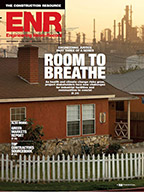Station Park has integrated elements of downtown Salt Lake City’s historic architecture into its blend of traditional Main Street design. Farmington’s historic charm and trademark sycamores are reflected throughout the project, while art deco-inspired graphics and signage welcome visitors from atop a series of logoed, 100-ft-tall pylon signs.
Designed both for flexibility and the ability to increase density overtime just as in any true urban setting, this suburban location provides opportunities for buildings to change uses, open spaces to be filled and buildings to be added. It’s a mix of urbanism and lifestyle center, with a true spirit of place.
What really draws crowds, however, is a state-of-the-art, 5,000-sq-ft show fountain. One of only two of its kind in the country, the fountain boasts technology that enables it to create a dazzling combination of colored lights, music, movement, and 30-ft- to 60-ft-high dancing waters. It also features a waterfall that flows into a lower pond and misting nozzles that send fog throughout the water feature.
Destination projects such as Station Park and Brookfield, Wis.’s yet-to-be-opened The Corners point to consumers’ changing tastes in shopping and demand for innovative design, leisure, and entertainment to be a part of their retail experiences. But in a tight market, how can smaller and older shopping centers compete?
In truth, they can’t, nor should they. But that doesn’t mean there isn’t a place for smaller shopping centers that not only provide the basics but also do so in a unique and individual place. Most people are not going to do their weekly food shopping, run to the dry cleaners, or get their hair cut at a destination center like Station Park. The trick for owners is to make certain these older shopping areas don’t look old.
Place-making again plays a key role here. Improving the facades of aging buildings to reflect the community in which they are located, adding new lighting, landscaping and signage to create a safer and more inviting environment, and creating courts and outdoor cafes where patrons can linger all contribute to effective place-making in a smaller shopping center.
In a country that is already over-retailed, reinvesting in existing properties has become increasingly commonplace. This reinvestment reduces the pressure on our natural resources by not developing on greenfield sites farther outside the current suburban sprawl. It is also typically less expensive because of reduced infrastructure costs. This redevelopment creates economic revitalization and can help stabilize existing communities.
In redeveloping existing shopping centers, the catch for designers, engineers and architects is to keep in mind the same place-making principles that are at play in a large-scale project like Station Park. Those principles also apply to that 12-store shopping center serving the local community. Applying them effectively can serve to reduce sprawl, stabilize communities and foster economic renewal.
Dustin Watson is a partner and the director of sustainability at the Baltimore-based design firm DDG, which delivers design, planning, architecture and graphics to commercial developments in cities, towns and suburbs around the world.


Post a comment to this article
Report Abusive Comment